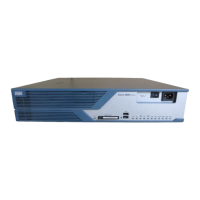General Site Requirements
5
Preinstallation Requirements and Planning for Cisco 3800 Series Routers
OL-5967-01
Site Configuration
The following precautions help you plan the operating environment for your router and help avoid
environmentally caused equipment failures:
• Ensure that the room where your router operates has adequate circulation. Electrical equipment
generates heat. Without adequate circulation, ambient air temperature may not cool equipment to
acceptable operating temperatures.
• Always follow ESD-prevention procedures described in the “Preventing Electrostatic Discharge
Damage” section on page 3 to avoid damage to equipment. Damage from static discharge can cause
immediate or intermittent equipment failure.
• Ensure that the router cover or motherboard tray and module rear panels are secure. All empty
network module slots, interface card slots, and power supply bays must have filler panels installed.
The router is designed to allow cooling air to flow within it through specially designed cooling slots.
A router with uncovered openings creates leaks that may interrupt and reduce the flow of air across
internal components.
Equipment Racks
You can install Cisco 3800 series routers in a 19-inch rack, or in a 23-inch rack with adapters from your
rack manufacturer. For mounting procedures, see the “Rack-Mounting the Router” section on page 10
of “Installing Cisco 3800 Series Routers in an Equipment Rack.”
Consider the following information when planning your equipment rack configuration:
• Allow clearance around the rack for maintenance.
• Enclosed racks must have adequate ventilation. Ensure that the rack is not congested, because each
router generates heat. An enclosed rack should have louvered sides and a fan to provide cooling air.
Heat generated by equipment near the bottom of the rack can be drawn upward into the intake ports
of the equipment above.
• When mounting a router in an open rack, ensure that the rack frame does not block the intake ports
or exhaust ports. If the router is installed on slides, check the router’s position when it is seated into
the rack.
• Baffles can help to isolate exhaust air from intake air, which also helps to draw cooling air through
the router. The best placement of the baffles depends on the airflow patterns in the rack, which can
be found by experimenting with different configurations.
• When equipment installed in a rack (particularly in an enclosed rack) fails, try operating the
equipment by itself, if possible. Power off other equipment in the rack (and in adjacent racks) to
allow the router being tested a maximum of cooling air and clean power.

